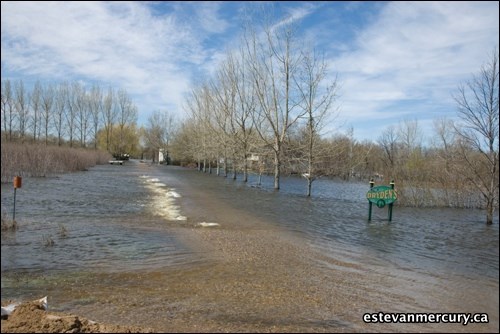Water, water everywhere.
If there were a phrase to sum up the spring and summer of 2011, that would have to be it. Without question 2011 was the year of the flood.
There may have been other stories that grabbed a significant number of headlines, but the sheer volume of water and the devastation left in its wake dominated the pages of The Mercury and other papers throughout the country, making it our top story of the year.
Although the flood first hit during the spring, the first sign that there may be trouble came as far back as January when the Saskatchewan Watershed Authority announced that for the first time since Rafferty Dam was created they would be conducting a winter release of water, citing the high level of the dam and anticipated spring runoff as the reasons why.
It was clear then that were concerns of a spring flood and it became obvious as the year went on those worries were well founded.
In April, the SWA announced it would be increasing the flows out of Rafferty and Boundary to 140 cubic metres per second. Not surprisingly, the release of the water led to flooding in the Souris River valley in areas of south of Estevan and to the east.
Unfortunately, as it would turn out, the April flood was just the first of many. Just as things appeared to be calming, a freak snowstorm in late April that dumped inches of heavy, wet snow on the area, threw things back into chaos and again forced the Watershed Authority to bump the flows out of Rafferty to 211 m3/s in mid May which again led to more flooding in the valley. Despite the best efforts of local volunteers, a number of homes suffered significant damage and other areas such as the Woodlawn Regional Park were hit hard.
Those incidents proved to be a precursor of the troubles that were lurking around the corner. Midway through June, a rainstorm that dumped anywhere from seven to eight inches on Weyburn in just hours once again turned things upside down. While Weyburn suffered significant damage in the immediate aftermath of the storm, the runoff took a couple of days to reach the Estevan and once it did, life was never the same again for many.
The watershed was forced to bump the flows out of the local dams to over 750 m3/s which was not only a record but a level that many thought they would never see. The devastation that would follow was incredible.
After fighting the good fight, the residents of Roche Percee were forced to admit the obvious and evacuate just prior to June 19 when the village was overcome by the water leading to the destruction of more than 75 per cent of homes.
In Estevan, emergency services personnel were forced to evacuate the residents of the Willow Park Greens mobile home park as the flood waters made it to the southern edge of the park. Fortunately there were no injuries or significant damage to the park.
The flood also led to some worries about the City's water treatment plant. The rising waters turned the plant into an island but did not make it inside due to the tireless work of City employees and local emergency services workers.
Unfortunately the flooding was not restricted to areas along the river. Overland flooding caused major damage throughout the RM of Estevan and other areas such as Macoun, Benson and Lampman.
The two biggest areas of concern were Lampman and Benson as a stream of water placed both communities into states of emergency.
In Benson, local officials put out the call for help and the call was answered as dozens of volunteers filled sandbags and erected dikes to protect to homes. A number of oil companies also sent out their pump trucks to help alleviate the water worries. Lampman had similar support as volunteers spent hours filling sandbags and building walls to keep the water back. The incredible efforts of those people managed to keep the damage in both communities to a minimum.
In fact, if there were any positives to take away from the devastating floods, it was the way people in the area stepped up to help those in need. Along with the hours of volunteer work, individuals and businesses donated thousands of dollars to help those in need while others supplied whatever items they could spare for those who lost almost everything.
Although the flood waters have long since receded, many are still dealing with the after effects. In Roche Percee, a number of families are still attempting to settle with the provincial government and have voiced their frustration over the difficulties they are having. More importantly those families, and others who lost their homes, are attempting to return to some type of normalcy after enduring the year of the flood.




